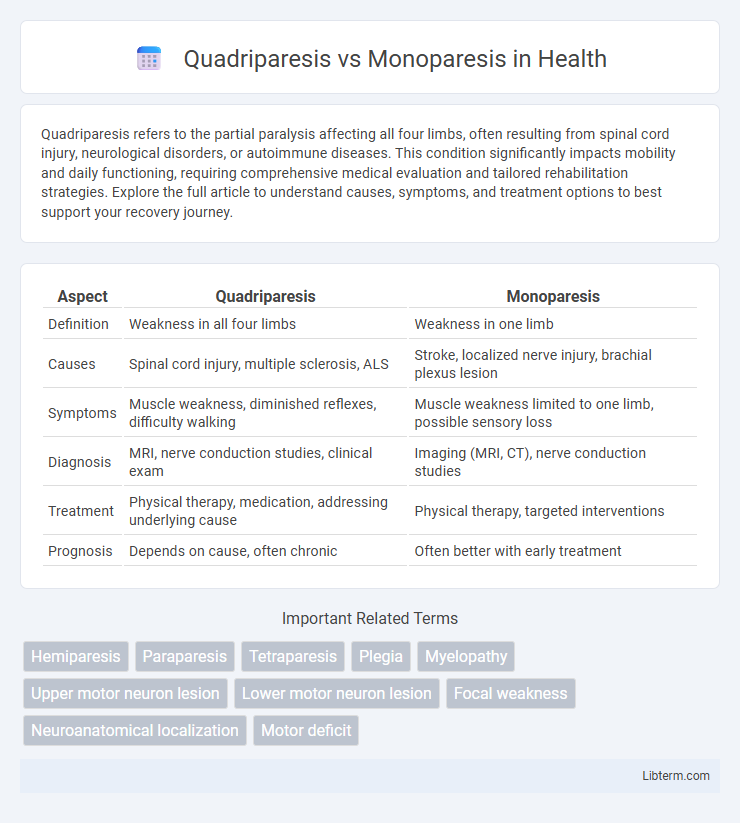Quadriparesis refers to the partial paralysis affecting all four limbs, often resulting from spinal cord injury, neurological disorders, or autoimmune diseases. This condition significantly impacts mobility and daily functioning, requiring comprehensive medical evaluation and tailored rehabilitation strategies. Explore the full article to understand causes, symptoms, and treatment options to best support your recovery journey.
Table of Comparison
| Aspect | Quadriparesis | Monoparesis |
|---|---|---|
| Definition | Weakness in all four limbs | Weakness in one limb |
| Causes | Spinal cord injury, multiple sclerosis, ALS | Stroke, localized nerve injury, brachial plexus lesion |
| Symptoms | Muscle weakness, diminished reflexes, difficulty walking | Muscle weakness limited to one limb, possible sensory loss |
| Diagnosis | MRI, nerve conduction studies, clinical exam | Imaging (MRI, CT), nerve conduction studies |
| Treatment | Physical therapy, medication, addressing underlying cause | Physical therapy, targeted interventions |
| Prognosis | Depends on cause, often chronic | Often better with early treatment |
Understanding Quadriparesis and Monoparesis
Quadriparesis is characterized by partial weakness in all four limbs, often resulting from neurological conditions such as spinal cord injury or multiple sclerosis. Monoparesis refers to weakness confined to a single limb, commonly caused by localized nerve damage or stroke. Differentiating between quadriparesis and monoparesis is essential for accurate diagnosis and targeted treatment strategies in neurology.
Key Differences Between Quadriparesis and Monoparesis
Quadriparesis involves partial paralysis affecting all four limbs, typically caused by spinal cord injury, neurological disorders, or certain infections, whereas monoparesis is characterized by weakness in only one limb, often resulting from localized nerve damage or stroke. Quadriparesis usually impairs both upper and lower extremities bilaterally, significantly impacting mobility and daily function, while monoparesis generally limits movement confined to a single arm or leg with less widespread disability. The diagnosis and treatment strategies differ, with quadriparesis requiring comprehensive neurological assessment and often intensive rehabilitation, whereas monoparesis may focus on targeted therapy and addressing specific nerve injuries.
Causes of Quadriparesis and Monoparesis
Quadriparesis, characterized by muscle weakness in all four limbs, commonly results from spinal cord injuries, multiple sclerosis, amyotrophic lateral sclerosis, or severe neuropathies affecting the cervical spinal cord or motor neurons. Monoparesis, involving weakness in a single limb, often arises from localized nerve injuries, stroke affecting specific brain regions, peripheral neuropathy, or focal nerve entrapment syndromes. Accurate diagnosis requires detailed neurological examination and imaging studies to differentiate the underlying causes of quadriparesis and monoparesis.
Common Symptoms and Clinical Presentation
Quadriparesis presents with symmetrical weakness in all four limbs, often accompanied by spasticity, muscle stiffness, and impaired fine motor skills, indicating widespread motor neuron involvement. Monoparesis typically manifests as weakness confined to one limb, frequently accompanied by localized muscle atrophy or sensory changes depending on the underlying nerve or spinal cord lesion. Both conditions may involve diminished reflexes, muscle fatigue, and altered coordination, but quadriparesis reflects a more extensive neurological impairment compared to the isolated presentation in monoparesis.
Diagnostic Approach for Paresis Conditions
Diagnosing quadriparesis versus monoparesis involves detailed neurological examination and targeted diagnostic tests to localize the lesion and determine its etiology. Magnetic resonance imaging (MRI) of the brain and spinal cord, nerve conduction studies, and electromyography (EMG) are essential to differentiate diffuse motor pathway involvement in quadriparesis from localized nerve or plexus lesions causing monoparesis. Laboratory evaluations such as cerebrospinal fluid analysis and blood tests for autoimmune markers or infections support the identification of underlying causes like multiple sclerosis, stroke, or neuropathies.
Treatment Options for Quadriparesis
Treatment options for quadriparesis primarily include physical therapy, occupational therapy, and medications such as muscle relaxants and corticosteroids to reduce inflammation. Advanced interventions may involve surgical procedures to address underlying causes like spinal cord injuries or herniated discs, alongside assistive devices to improve mobility and daily function. Early and multidisciplinary rehabilitation significantly enhances recovery outcomes in patients with quadriparesis.
Management Strategies for Monoparesis
Management strategies for monoparesis focus on targeted physical therapy to improve muscle strength and coordination in the affected limb, often incorporating neuromuscular electrical stimulation to enhance recovery. Pharmacologic treatments may include muscle relaxants and pain management tailored to the underlying cause, such as corticosteroids for inflammation or antispasmodics for muscle stiffness. Early intervention with occupational therapy helps restore functional independence and prevents secondary complications like joint contractures or muscle atrophy.
Prognosis and Recovery Outcomes
Quadriparesis involves weakness in all four limbs, often resulting from spinal cord injury or neurological disorders, and typically has a more guarded prognosis with prolonged recovery times compared to monoparesis. Monoparesis affects only one limb and generally has a better recovery outcome, especially if caused by localized nerve damage or partial stroke, allowing for more targeted rehabilitation. Early intervention and tailored physical therapy significantly influence functional recovery and long-term prognosis in both conditions.
Preventive Measures for Neuromuscular Disorders
Preventive measures for neuromuscular disorders causing quadriparesis or monoparesis emphasize early diagnosis, maintaining a healthy lifestyle, and avoiding exposure to neurotoxic agents. Regular physical activity, proper nutrition rich in antioxidants, and managing chronic conditions such as diabetes help reduce the risk of nerve damage. Vaccination against infections like poliovirus and adherence to ergonomic practices also play crucial roles in prevention.
Living With Paresis: Patient Support and Rehabilitation
Living with quadriparesis involves comprehensive rehabilitation focusing on improving mobility, enhancing muscle strength, and managing daily activities through physical and occupational therapy tailored to severe weakness in all four limbs. In contrast, living with monoparesis requires targeted interventions that concentrate on the affected single limb to restore function, increase independence, and prevent muscle atrophy. Both conditions benefit from multidisciplinary patient support systems that include psychological counseling, adaptive equipment, and personalized care plans to optimize quality of life.
Quadriparesis Infographic

 libterm.com
libterm.com